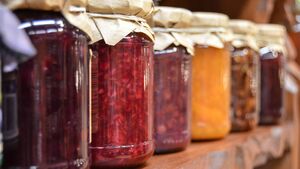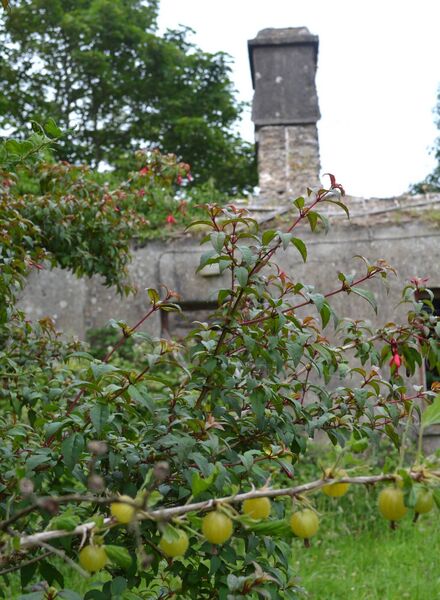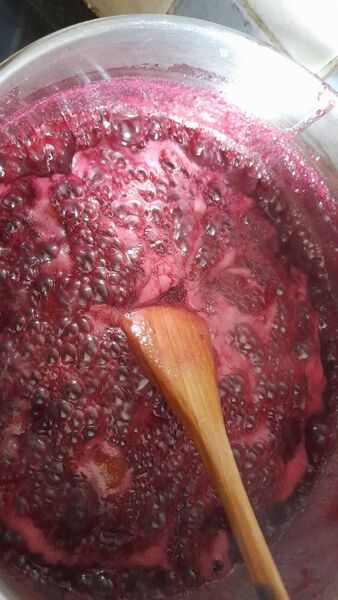Jam-making was once a big part of rural life

Homemade jam has a timeless appeal.
There is a certain something about a pot of homemade jam; the craft of preserving summer fruits, the colour, the aroma, the joy in its making and the pleasure in its eating.
A few years ago, on one of my photographic journeys through the Ox Mountains, I came across a few old gooseberry bushes growing wild in a cottage garden somewhere over Killasser. The sprawling branches still bore a fine crop of sweet berries, long after the woman of the house was dead and gone. I imagine she loved those bushes and the joy that they gave her each year when jam-making season came around.

Jam has been made and eaten by people through the centuries, from Ancient Greece to the present day. The history of this sweet invention is quite interesting, more interesting than you might think at first glance.
Jam-making is linked to some of the earliest methods of preserving food, which date all the way back to the Stone Age - about 2.6 million years ago! During the Stone Age, people discovered ways to preserve items for later use, to a time of year when food was scarce.
Freshways, a company which prides itself on providing a range of wholesale foods throughout the UK, take us right back to the first recorded accounts of jam-making.
During the Crusades (1095 to 1492), soldiers brought back sugar from the Middle East to Western Europe. This significantly boosted the popularity of jam as it made the process of making jam much easier. As a result, production began to take off.
The first recorded mention of sugar in England is from 1099 and it was often described as a pleasant ‘new spice’. Records from 1319 list sugar available in London for ‘two shillings per pound’ – that’s roughly £36 per pound in today’s money. Jam grew in popularity across Europe, particularly amongst soldiers and sailors. Some sailors began to stockpile jam aboard their ships for long voyages. People had begun to make the link between vitamin C and scurvy, and fruit preserved in sugar was better than no fruit at all!
In the 19th century, the invention of canning changed the way people preserved food. Canning allowed fruits and vegetables to be preserved without the need for either sugar or honey. Jam-making eventually developed further when it was discovered that cooking fruit with sugar and pectin improved consistency and setting. The addition of pectin, a natural thickening agent found in fruit, proved vital and helped create the firmer and more spreadable jam that we are familiar with today.
My mother was a great jam maker… that is to say, she made a great lot of jam. To be honest, and God forgive me for this, but I never thought her jam was great. It had a short use by date. This, however, was offset by the fact that it was usually gobbled up before that mattered.
Having said all that, I have no doubt, my mother was doing her very best. You see, my father loved to be productive and few garden projects are more productive than fruit growing - a nice line of raspberry canes here and a well-manured row of blackcurrant bushes there. He even pulled the rhubarb and picked the various berries, some of them from very thorny bushes.
However, it was left to my mother to preserve the harvest that he piled high on her kitchen table. My mother never seemed able to confront my father on this issue. Firstly, he had done all the hard work in the garden. Secondly, he was always so proud of himself and his productive pastime that it was hard to fault his efforts.
My mother was left to top and tail the fruit, find a million jam pots, buy a cartload of sugar and then preside over a lengthy jam-boiling routine. In her defence, it must be said, she had no time for such a time-consuming project. She had more than enough to be doing without having to spend the days of summer boiling jam over a hot stove. She made three square meals each day for a large family, she washed clothes, she baked bread and she milked cows - morning and evening.
And so, our kitchen became a veritable jam factory every summer. The whole process created a lovely smell in the house, apart from when the big pot boiled over on top of the range. The jam-making seemed to go on for weeks. Each day the giant cauldron on the range was filled again and each evening the shelves on the old dresser sagged a little lower from the weight of freshly filled pots of jam. Generally, the whole operation passed without much incident, apart from the occasional scalding.

The thing is that jam made in a rush seldom turns out well. The jars don’t always get the full sterilising treatment, the jam may not get boiled for long enough and the lids may not always get fully tightened. Then, the jam may not always get stored in perfect conditions.
Some of the jam my mother made got used straight away at home; smothered over her lovely homemade bread. The rest of it was passed on as gifts. We never had any complaints, but I am fairly certain that a substantial amount of jam, with a pretty high alcohol content, was consumed by our neighbours and friends over the years.
A few years before my mother passed away, I reluctantly accepted a pot of her latest offering. It was made of rhubarb and she said she had recently heard that if used for jam-making in July, rhubarb gives a better set. This exchange took place at a time, pre-Covid when my B&B business was in full swing. I checked the jam and it seemed… non-explosive. So, for afternoon tea the following day, I set it out for my German guests. Well, they loved it! And when I told them it had been made by my aged mother, they loved it even more.
I had plenty jams of my own making at the time; various varieties, countless colours. They were perfectly set and expertly sealed; jams that could last for months, even years. Next morning, I placed a good selection of them on the breakfast table so that I could receive some compliments on my own jam-making abilities. Alas, nothing would do the guests but for me to take them all away and replace them with my mother’s rhubarb jam – the finest jam they had ever tasted!






